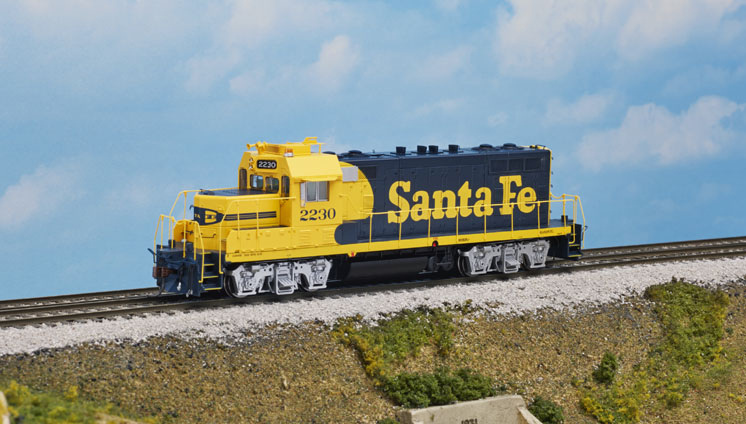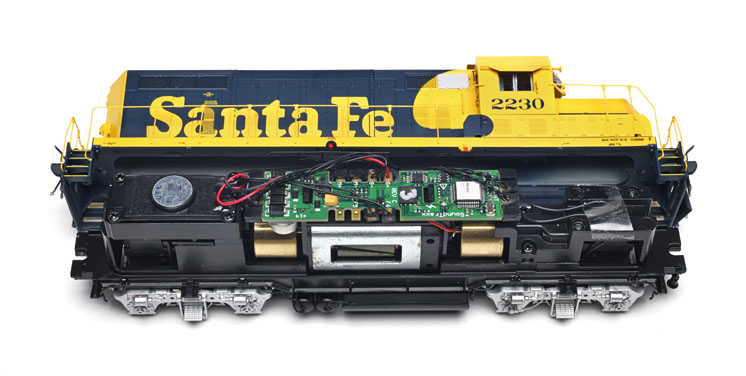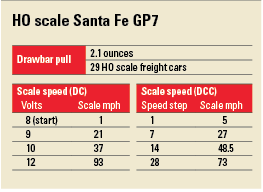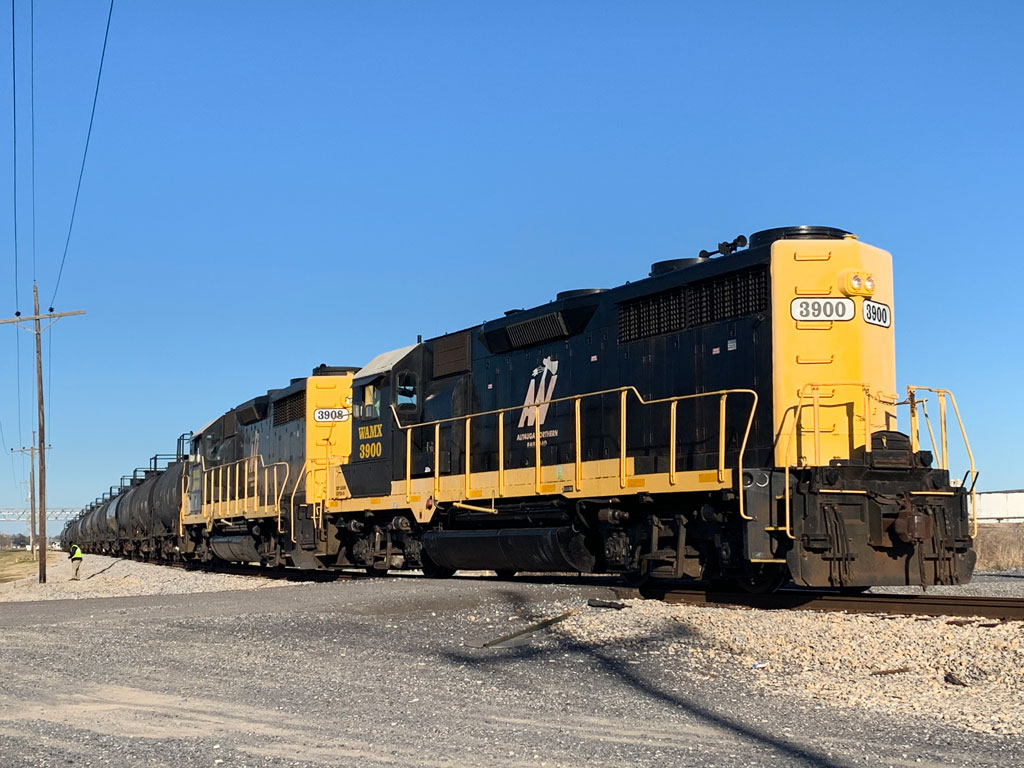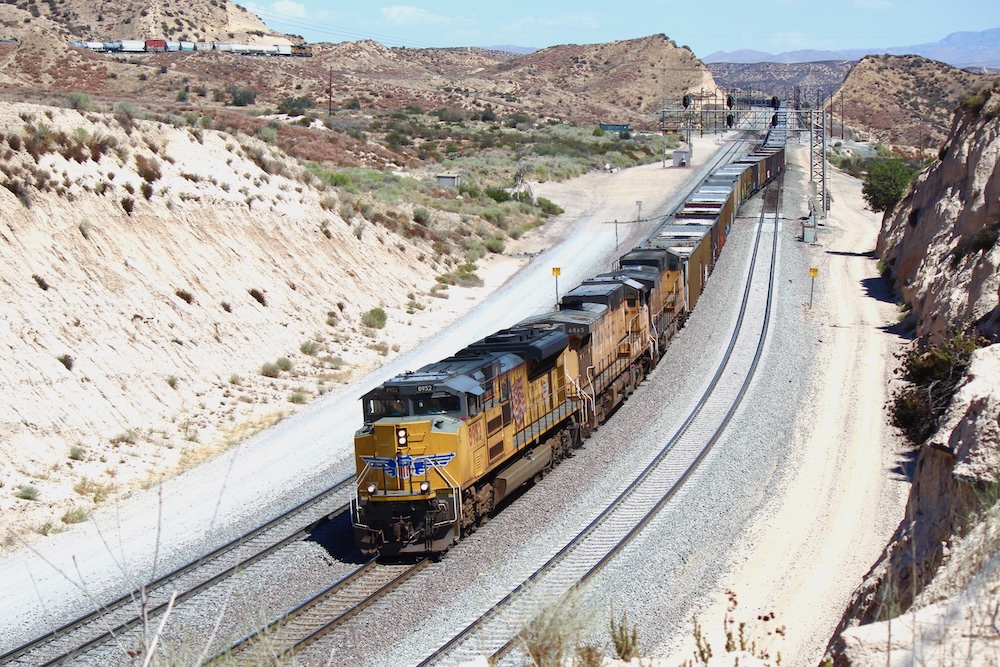A well-executed Atchison, Topeka & Santa Fe chop-nose GP7 has been added to Athearn’s HO scale Genesis line. The model features road number-specific details, etched-metal radiator intake and fan grills, and a dual-mode SoundTraxx sound decoder.
Athearn offers the Santa Fe GP7 in two body styles. The Phase I body has 86″ engine compartment doors and lacks dynamic brakes, while the Phase II body has 86″ and 82″ doors and an early blanked dynamic brake hatch.
Santa Fe began rebuilding its aging Electro-Motive Division GP7 diesel locomotives at its Cleburne, Texas, shops in 1972. The railroad divided the 1,500 hp locomotives into three classes: 1310 through 1329 (mother units paired with slugs), 2000 through 2026, and 2050 through 2243. The Athearn model is based on locomotives from the last class. To railfans, the rebuilt Geeps were known as a GP7u (for upgraded). To the railroad, they were still GP7s.
Units 2050-2067 were rebuilt with rounded cab roofs. The rest of the class (2068-2243) had angled “Topeka cabs.” The last GP7s were rebuilt in 1981.
As with most rebuild programs, there were changes to Santa Fe’s GP7s over the years. Units 2068 through 2089 had small number boxes that weren’t flush with the roofline, while units 2090 through 2243 had wide boxes even with the roof. The placement of the antenna, horn, and headlights; the style of sill skirt; and the use of a rooftop beacon also varied between units.
Not only did the appearance of the GP7s change after rebuilding, so did their uses on the railroad. The former road units were now assigned to yard switching and local service. Some of the rebuilt GP7s served on the BNSF Ry.
Our sample is decorated as Santa Fe no. 2230, which represents a Phase I GP7. The model also features a working Prime Stratolite beacon, small emergency fuel cutoff tab on the sill, and a 1,600-gallon fuel tank.
The GP7 has the same high level of detail as other Genesis series models. Our sample has a Vapor rooftop air conditioner, an antenna plate with a Sinclair antenna, wire grab irons, separate m.u. cables and uncoupling levers, Blomberg B trucks with the outer brake shoes removed, and metal lift rings.
The Acetal handrails are well detailed, with tees where the vertical stanchions intersect with the horizontal rail and chain detail on the front and rear. On our sample, some of the stanchions on the long hood lean forward.
The model’s paint is smooth and evenly applied, with crisp color separation on the warbonnet. There are a few voids in the Santa Fe lettering on the hood, but that can be fixed with yellow paint and a fine brush. All of the small stencils are legible under magnification.
To reach the mechanism, I removed the front and rear draft-gear boxes and lifted off the plastic shell. Do this carefully, as the headlight wires are attached to the inside of the shell.
The mechanism arrangement matches other Genesis series Geeps. A five-pole skew-wound motor and two flywheels are attached to the center of the die-cast metal frame. To accommodate the speaker and low short hood, there are no additional weights attached above either gearbox.
A printed-circuit (PC) board and SoundTraxx decoder are located above the motor. The speaker is mounted
over the gear tower on the rear truck.
I tested the GP7 on DC using a Model Rectifier Tech II Railmaster 2400 power pack. The sounds came on at 6.2V, and the unit started moving at a scale 1 mph at 8.0V. The model achieved a top speed of 93 scale mph at 12V. This is 20 scale mph faster than the prototype’s top speed.
Then I tested the GP7 using NCE’s Power Cab Digital Command Control system. The model’s top speed was a scale 73 mph, spot on with the prototype.
I was able to improve the slow speed performance by changing from 28 to 128 speed steps. With the adjustment, the GP7 crawled along at 1 scale mph at speed step 1.
Next, I put the GP7 on our club layout. First, I switched industries on our Wisconsin & Southern project layout. The model performed well, operating smoothly over the no. 5 turnouts.
I then tried tackling the 3 percent grade on the Milwaukee, Racine & Troy. The GP7 pulled six 54-foot covered hoppers up the grade effortlessly. With a drawbar pull of 2.08 ounces, the model can pull 29 cars on straight and level track. This is appropriate for a locomotive used in yard and branchline service.
The SoundTraxx sound decoder works on DC and DCC layouts. Some functions are limited on DC, but users can still enjoy the diesel engine rumble, horn, and bell. The bell rings when the diesel begins moving. A grade crossing horn sequence (long, long, short, long) can be activated by quickly flipping the direction switch back and forth. The headlights are directional, and the rooftop beacon works. These effects can be disabled with a DCC system.
The complete library of user-triggered sound effects and lighting features can be controlled with DCC. The headlight, bell, long and short horn blasts, rooftop beacon, dimmer, mute, dynamic brakes, brake squeal, and coupler crash can be activated using functions zero through 10.
Information on basic configuration variable (CV) settings, advanced sound features, and optional horns (including CV values) are listed in the operator’s manual and sound guide. A more
detailed DCC manual is available at www.athearn.com/dcc.
Santa Fe’s rebuilt GP7s had a very distinctive appearance, and Athearn has done a great job capturing all of the
details from the top of the Topeka cab to the modified Blomberg B trucks.
Price: direct-current models, $189.98; with dual-mode SoundTraxx sound decoder, $289.98
Manufacturer
Athearn Trains
1600 Forbes Way, Ste. 120
Long Beach, CA 90810
www.athearn.com
Era: 1981 to 1993 (as decorated)
Features
▪▪All-wheel drive and electrical pickup
▪▪Body mounted McHenry scale couplers at correct height
▪▪Five-pole skew-wound motor with flywheels
▪▪Minimum radius: 18″
▪▪Operating Prime Stratolite beacon
▪▪Quick Plug with eight- and nine-pin connector (DC only)
▪▪RP-25 contour metal wheelsets, in gauge
▪▪Weight: 10.7 ounces





